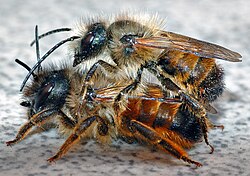Mason bee
| Mason bee | |
|---|---|
 |
|
| Osmia rufa | |
| Scientific classification | |
| Kingdom: | Animalia |
| Phylum: | Arthropoda |
| Class: | Insecta |
| Order: | Hymenoptera |
| Family: | Megachilidae |
| Subfamily: | Megachilinae |
| Tribe: | Osmiini |
| Genus: |
Osmia Panzer, 1806 |
| Species | |
|
>300 species, including |
|
>300 species, including
Mason bee is a name now commonly used for species of bees in the genus Osmia, of the family Megachilidae. Historically, the term mason bee has also been used to describe bees of Chalicodoma and Megachilidae, most notably in "The Mason-Bees" by Jean-Henri Fabre and his translator Alexander Teixeira de Mattos in 1914. Mason bees are named for their habit of using mud or other “masonry” products in constructing their nests, which are made in naturally occurring gaps such as between cracks in stones or other small dark cavities; when available some species preferentially use hollow stems or holes in wood made by wood-boring insects.
Species of the genus include the orchard mason bee Osmia lignaria, the blueberry bee O. ribifloris, and the hornfaced bee O. cornifrons. The former two are native to the Americas and the latter to Japan, although O. lignaria and O. cornifrons have been moved from their native ranges for commercial purposes. The red mason bee, Osmia rufa, is found across the European continent. Over 300 species are found across the Northern Hemisphere;. Most occur in temperate habitats within the Palearctic and Neartic zones, and are active from spring through late summer.
Osmia species are frequently metallic green or blue, though many are blackish and at least one rust-red. Most have black ventral scopae which are difficult to notice unless laden with pollen. They have arolia between their claws, unlike Megachile or Anthidium species.
Unlike honey bees (Apis) or bumblebees, Osmia species are solitary; every female is fertile and makes her own nest, and no worker bees for these species exist.
When the bees emerge from their cocoons, the males exit first. The males typically remain near the nests waiting for the females, and some are known to actively extract females from their cocoons. When the females emerge, they mate with one or several males. The males soon die, and within a few days the females begin provisioning their nests.
...
Wikipedia
